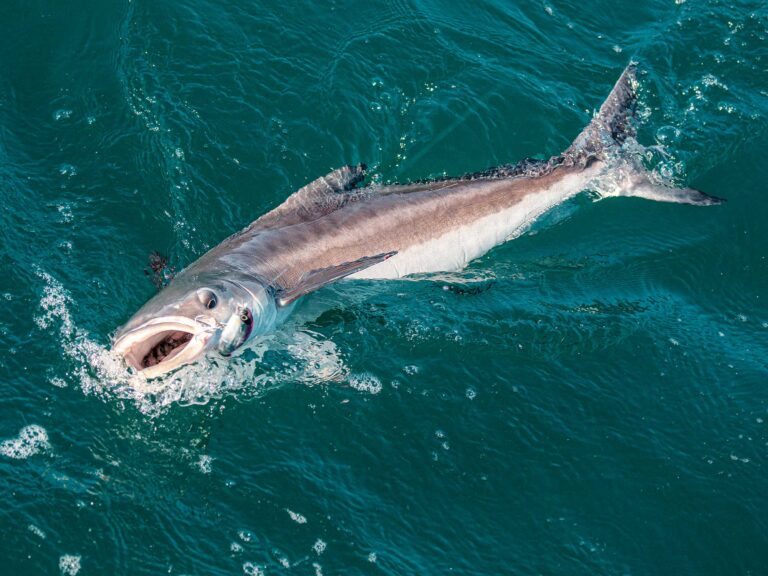The Recreational Fishing Alliance (RFA) has been busy on Capitol Hill this week opposing efforts to re-open areas currently closed to pelagic drift longlining.
On March 31, 2005, the National Marine Fisheries Service (NOAA Fisheries) released a Final Environmental Assessment proposing to issue Exempted Fishing Permits (EFP) to conduct scientific research experiments using pelagic longline gear in areas of the Gulf of Mexico, Florida East Coast, South Atlantic Bight, Mid-Atlantic Bight and Northeast Coastal Atlantic currently closed to this gear type.
NOAA Fisheries concludes in the Environmental Assessment that such EFPs would have “no significant impact” on the marine environment.
“We strongly disagree that allowing longlining in areas currently closed to the gear would have ‘no significant impact’,” said Jim Donofrio, RFA Executive Director. “Past Biological Opinions, Environmental Impact Statements, public comments, rulemakings and judicial decisions clearly support the need for the current closures. Any proposed longline research can be done outside closed areas.”
While each of these areas were closed to longlining because of the unacceptable level of juvenile swordfish or bluefin tuna bycatch, longlines were also responsible for very high levels of blue marlin, white marlin and sailfish bycatch in these areas.
There is no question blue marlin, white marlin and sailfish will be killed on longlines in these areas if they are reopened. How many blue marlin will be caught by vessels fishing under these EFPs? How many white marlin? How many sailfish? How many will be dead by the time the gear is hauled back to the vessel? The Environmental Assessment does not adequately address these questions.
“We’ve heard from several members, particularly in Florida, who are outraged that these areas could be re-opened to longlining,” said Mr. Donofrio. “We’re doing everything we can to keep longlines out of these waters.”
A letter detailing the RFA’s position follows:
April 7, 2005
Dr. Christopher Rogers, Chief
Highly Migratory Species Management Division
National Marine Fisheries Service
1315 East West Highway
Silver Spring MD 20910
Via fax and regular mail: 301-713-1917
Re: Final Environmental Assessment for Exempted Fishing Permits
Dear Dr. Rogers:
On behalf of the Recreational Fishing Alliance (RFA), I am writing to express our serious concerns with the Final Environmental Assessment for Exempted Fishing Permits (EFP) released March 31, 2005.
As you know from several communications with the RFA over the last several years, we are strongly opposed to re-opening areas currently closed to pelagic drift longlining. Therefore, we are strongly opposed to the National Marine Fisheries Service (NOAA Fisheries) issuing EFPs to conduct scientific research experiments using pelagic longline gear in areas of the Gulf of Mexico, Florida East Coast, South Atlantic Bight, Mid-Atlantic Bight or Northeast Coastal Atlantic currently closed to this gear type. We take serious issue with the NOAA Fisheries conclusion that such EFPs will have “no significant impact” based on the following.
First, NOAA Fisheries is proposing to authorize “scientific research to determine whether gear modifications and/or various fishing techniques can be found to avoid/reduce bycatch and associated regulatory discards of juvenile highly migratory species (HMS)?” (See Final Environmental Assessment p. ii). There is no justifiable reason why this research cannot be done outside the few discrete areas of the Atlantic and Gulf currently closed to pelagic longlining.
Past Biological Opinions, Environmental Impact Statements, public comments, rulemakings and judicial decisions clearly support the necessity of the current closures. Allowing pelagic longline gear back into these areas would be in direct conflict with the original intent of the closures. Any proposed longline research can be done outside closed areas.
Second, NOAA Fisheries claims “the action is not expected to jeopardize the sustainability of any non-target species?” (See Final Environmental Assessment p. iv). While each of these areas were closed to longlining because of the unacceptable level of juvenile swordfish and bluefin tuna bycatch, longlines were also responsible for very high levels of blue marlin, white marlin and sailfish bycatch in these areas.
There is no question blue marlin, white marlin and sailfish will be killed on longlines in these areas if they are reopened. How many blue marlin will be caught by vessels fishing under these EFPs? How many white marlin? How many sailfish? How many will be dead by the time the gear is hauled back to the vessel? The Environmental Assessment does not adequately address these questions.
Furthermore, with the entire U.S. fishing fleet restricted to landing 250 recreationally-caught blue and white marlin, how can NOAA Fisheries be confident that the number of blue and white marlin killed on longlines in these closed areas will not jeopardize the sustainability of these non-target species? Any number of marlin killed as a result of these permits would be significant considering this strict annual quota that is in place. We are unconvinced that issuing these EFPs “is not expected to result in cumulative adverse effects that could have a substantial effect on?non-target species.” (See Final Environmental Assessment p. v).
With a white marlin Endangered Species Act (ESA) listing still looming over the heads of U.S. fishermen, we fail to see how NOAA Fisheries could draw this conclusion of “no significant impact” so easily.
Third, the Environmental Assessment is completely devoid of any economic analysis of the impact the issuance of these permits will have on the recreational fishing sector. Marlin, sailfish, swordfish and tuna are vastly important to the recreational fishing communities of Florida and other states along the Atlantic and Gulf Coasts. Highly Migratory Species are too valuable to be squandered by the very gear that the public and NMFS banned in an attempt to conserve them.
Fourth, NOAA Fisheries should be well aware that re-opening these closed areas to longlining is highly controversial. We fail to understand how “NMFS does not believe that the action will be highly controversial since few comments were received from the public regarding this proposed exempted fishing activity?” (See Final Environmental Assessment p. v). The RFA is on record several times strongly opposing re-opening these areas to longlining with letters dated March 11, 2003, December 11, 2003, and January 26, 2004. We would be happy to make copies of these letters available upon request. This issue has also proven to be highly controversial among members of the HMS Advisory Panel.
Finally, we fail to understand how NOAA Fisheries can claim that “the action is not likely to establish a precedent for future actions” (See Final Environmental Assessment p. vi). Clearly, the goal of the applicants is to re-open these areas to pelagic longlining. The applicants say as much in their April 7, 2005 press release: “Ultimately, some areas could be reopened under limited and rigorously controlled measures for our domestic fishermen.” (See Fisheries Research Institute press release April 7, 2005). In light of all the available evidence, we are convinced that even “under limited and rigorously controlled measures”, longlines in these waters will result in unacceptable levels of bycatch.
In conclusion, please allow me to reiterate, the RFA is strongly opposed to the NOAA Fisheries issuing EFPs to conduct scientific research experiments using pelagic longline gear in areas of the Gulf of Mexico, Florida East Coast, South Atlantic Bight, Mid-Atlantic Bight or Northeast Coastal Atlantic currently closed to this gear type.
Thank you for your time and consideration of our position on this matter.
Very truly yours,
Herbert P. Moore, Jr.
Counsel
The Recreational Fishing Alliance is a national, grassroots political action organization representing recreational fishermen and the recreational fishing industry on marine fisheries issues. The RFA Mission is to safeguard the rights of saltwater anglers, protect marine, boat and tackle industry jobs, and ensure the long-term sustainability of our Nation’s saltwater fisheries. For more information, call 1-888-JOIN-RFA.









